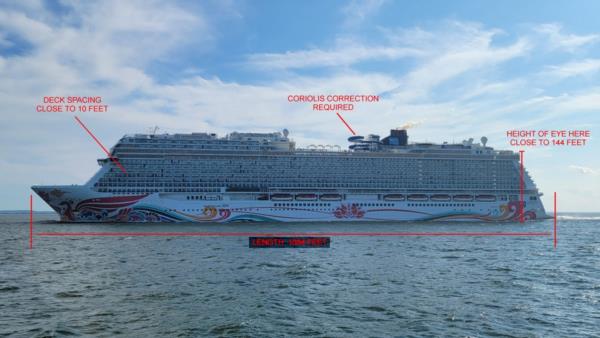
NavList:
A Community Devoted to the Preservation and Practice of Celestial Navigation and Other Methods of Traditional Wayfinding
From: Frank Reed
Date: 2024 Jan 24, 08:01 -0800
"Regarding the height of eye, the first day of the cruise I asked customer service for the heights of ..."
And you trusted them?! ;) Ha ha.
There are various methods for estimating dip on a cruise ship or other big boat...
You can estimate dip by tossing things over the side. Drop a rock or other dense object over the side and time the fall. If you can do that and time it to the nearest quarter of a second, your dip in minutes of arc is approximately the seconds of fall time multiplied by 3.9 [this gives dip directly because both the dip of the horizon and the fall time of a suitably dense, low air-resistance object are both directly proportional to square root of height]. Of course, tossing stuff over the side is probably a good way to get thrown off a cruise ship, but maybe on a container ship it would be allowed...
Another option: if you're alongside a pier, and there's some object of known size clearly visible close to the ship, then you can use your sextant to measure its angular size. For angles up to a few degrees, the math is easy (no trig required!): size/distance=angle/3438 which, of course, is equivalent to distance=size×3438/angle, where the angle is in minutes of arc. An example: suppose you see an object that you know is exactly six feet long floating in the water close to your ship. You measure its angular size with your sextant and find that it's 3°20' across. That's 200 m.o.a. Plugging that in gives a distance of 103 feet. That's good enough for dip estimation. Junk floating around in harbors is less common than it used to be, so maybe you can't rely on this method either... I should add that you need to worry about sextant parallax at such short ranges.
The most reliable method that I have found for estimating height of eye on large vessels is from photos. You find (or take with your camera or phone!) a photo of your ship that is more or less a side view. It doesn't have to be perfectly side on, but it makes life easier. Then, if you have some basic digital image skills, you can count pixels. It's even possible to scale your image so that pixels correspond one-to-one with feet of scale (or some other convenient unit) as in my image here. If you don't have any digital skills, print the photo and get out the ruler! From there it's simple scaling. The length of the vessel gives you a scale in the image or on the page, and then you can use that to measure heights of decks and other arbitrary points where you might be able to take your sights. This image is a photo of your vessel, Norwegian Joy, grabbed from wikimedia commons, re-scaled to one foot per pixel. I've marked it up with some height estimates and other points of interest.
Frank Reed
PS: Did you get any sights from the Coriolis Simulator? It's nice that they include one on this vessel for celestial navigation experiments. I'm sure most passengers don't realize its intended purpose.







